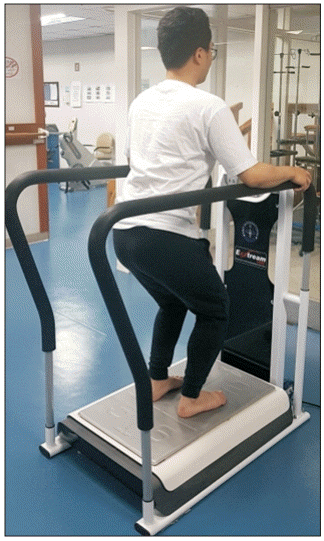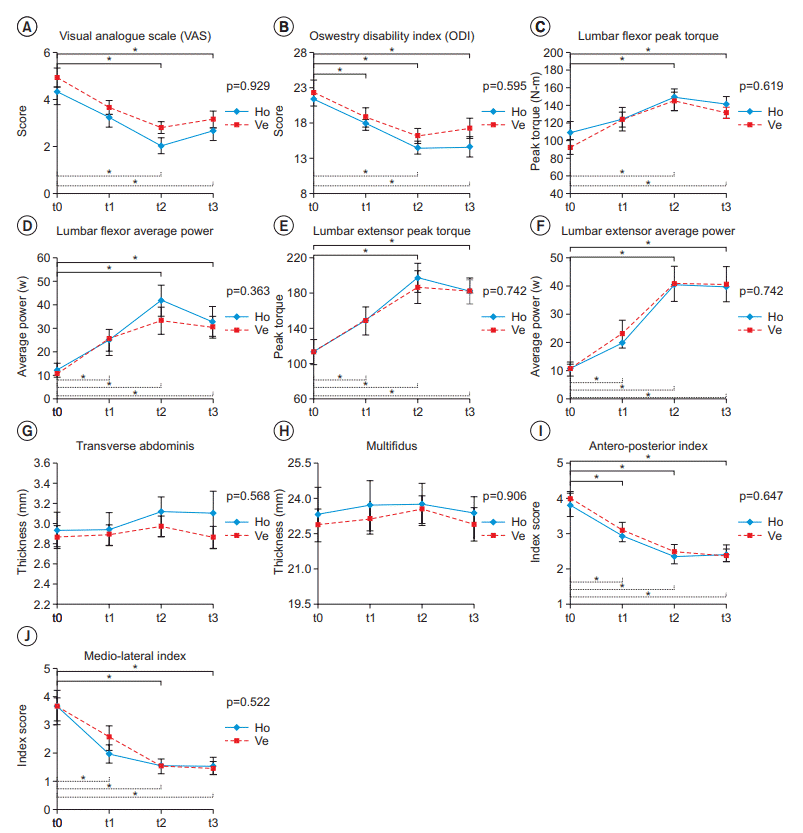1. Krismer M, van Tulder M; Low Back Pain Group of the Bone and Joint Health Strategies for Europe Project. Strategies for prevention and management of musculoskeletal conditions. Low back pain (non-specific). Best Pract Res Clin Rheumatol. 2007; 21:77–91.
2. Trapp W, Weinberger M, Erk S, Fuchs B, Mueller M, Gallhofer B, et al. A brief intervention utilising visual feedback reduces pain and enhances tactile acuity in CLBP patients. J Back Musculoskelet Rehabil. 2015; 28:651–60.

3. Bagheri R, Takamjani IE, Dadgoo M, Sarrafzadeh J, Ahmadi A, Pourahmadi MR, et al. A protocol for clinical trial study of the effect of core stabilization exercises on spine kinematics during gait with and without load in patients with non-specific chronic low back pain. Chiropr Man Therap. 2017; 25:31.

4. Graves JE, Pollock ML, Foster D, Leggett SH, Carpenter DM, Vuoso R, et al. Effect of training frequency and specificity on isometric lumbar extension strength. Spine (Phila Pa 1976). 1990; 15:504–9.

5. Gill KP, Callaghan MJ. The measurement of lumbar proprioception in individuals with and without low back pain. Spine (Phila Pa 1976). 1998; 23:371–7.

6. Iverson BD, Gossman MR, Shaddeau SA, Turner ME Jr. Balance performance, force production, and activity levels in noninstitutionalized men 60 to 90 years of age. Phys Ther. 1990; 70:348–55.

7. Wang XQ, Pi YL, Chen PJ, Chen BL, Liang LC, Li X, et al. Whole body vibration exercise for chronic low back pain: study protocol for a single-blind randomized controlled trial. Trials. 2014; 15:104.

8. Chen H, Ma J, Lu B, Ma XL. The effect of whole-body vibration training on lean mass: a PRISMA-compliant meta-analysis. Medicine (Baltimore). 2017; 96:e8390.
9. Park SY, Son WM, Kwon OS. Effects of whole body vibration training on body composition, skeletal muscle strength, and cardiovascular health. J Exerc Rehabil. 2015; 11:289–95.

10. Bagheri J, van den Berg-Emons RJ, Pel JJ, Horemans HL, Stam HJ. Acute effects of whole-body vibration on jump force and jump rate of force development: a comparative study of different devices. J Strength Cond Res. 2012; 26:691–6.

11. del Pozo-Cruz B, Hernandez Mocholi MA, Adsuar JC, Parraca JA, Muro I, Gusi N. Effects of whole body vibration therapy on main outcome measures for chronic non-specific low back pain: a single-blind randomized controlled trial. J Rehabil Med. 2011; 43:689–94.

12. Rittweger J, Just K, Kautzsch K, Reeg P, Felsenberg D. Treatment of chronic lower back pain with lumbar extension and whole-body vibration exercise: a randomized controlled trial. Spine (Phila Pa 1976). 2002; 27:1829–34.
13. Sitja Rabert M, Rigau Comas D, Fort Vanmeerhaeghe A, Santoyo Medina C, Roque i Figuls M, Romero-Rodriguez D, et al. Whole-body vibration training for patients with neurodegenerative disease. Cochrane Database Syst Rev. 2012; (2):CD009097.

14. Kaeding TS, Karch A, Schwarz R, Flor T, Wittke TC, Kuck M, et al. Whole-body vibration training as a workplace-based sports activity for employees with chronic low-back pain. Scand J Med Sci Sports. 2017; 27:2027–39.

15. Gillan SN, Sutherland S, Cormack TG. Vitreous hemorrhage after whole-body vibration training. Retin Cases Brief Rep. 2011; 5:130–1.

16. Vela JI, Andreu D, Diaz-Cascajosa J, Buil JA. Intraocular lens dislocation after whole-body vibration. J Cataract Refract Surg. 2010; 36:1790–1.

17. Kiiski J, Heinonen A, Jarvinen TL, Kannus P, Sievanen H. Transmission of vertical whole body vibration to the human body. J Bone Miner Res. 2008; 23:1318–25.

18. Lee G. Does whole-body vibration training in the horizontal direction have effects on motor function and balance of chronic stroke survivors? A preliminary study. J Phys Ther Sci. 2015; 27:1133–6.

19. Shim C, Lee Y, Lee D, Jeong B, Kim J, Choi Y, et al. Effect of whole body vibration exercise in the horizontal direction on balance and fear of falling in elderly people: a pilot study. J Phys Ther Sci. 2014; 26:1083–6.
20. Jung IG, Yu IY, Kim SY, Lee DK, Oh JS. Reliability of ankle dorsiflexion passive range of motion measurements obtained using a hand-held goniometer and Biodex dynamometer in stroke patients. J Phys Ther Sci. 2015; 27:1899–901.

21. Sweeney N, O’Sullivan C, Kelly G. Multifidus muscle size and percentage thickness changes among patients with unilateral chronic low back pain (CLBP) and healthy controls in prone and standing. Man Ther. 2014; 19:433–9.

22. Nuzzo JL, Haun DW, Mayer JM. Ultrasound measurements of lumbar multifidus and abdominal muscle size in firefighters. J Back Musculoskelet Rehabil. 2014; 27:427–33.

23. Sohn MK, Lee SS, Song HT. Effects of acute low back pain on postural control. Ann Rehabil Med. 2013; 37:17–25.

24. Glave AP, Didier JJ, Weatherwax J, Browning SJ, Fiaud V. Testing postural stability: are the star excursion balance test and Biodex Balance System limits of stability tests consistent? Gait Posture. 2016; 43:225–7.

25. Kakigi R, Shibasaki H. Mechanisms of pain relief by vibration and movement. J Neurol Neurosurg Psychiatry. 1992; 55:282–6.

26. Shilpapriya M, Jayanthi M, Reddy VN, Sakthivel R, Selvaraju G, Vijayakumar P. Effectiveness of new vibration delivery system on pain associated with injection of local anesthesia in children. J Indian Soc Pedod Prev Dent. 2015; 33:173–6.

27. Torvinen S, Kannus P, Sievanen H, Jarvinen TA, Pasanen M, Kontulainen S, et al. Effect of four-month vertical whole body vibration on performance and balance. Med Sci Sports Exerc. 2002; 34:1523–8.

28. Perchthaler D, Grau S, Hein T. Evaluation of a six-week whole-body vibration intervention on neuromuscular performance in older adults. J Strength Cond Res. 2015; 29:86–95.

29. Baard ML, Pietersen J, van Rensburg SJ. Interventions for chronic low back pain: whole body vibration and spinal stabilisation. S Afr J Sports Med. 2011; 23:35–9.

30. Torabi M, Okhovatian F, Naimi SS, Baghban AA, Vafaee R. The effect of core stability training with and without whole body vibration in chronic low back pain patients. J Paramed Sci. 2013; 4:17–25.
31. Hagbarth KE, Hongell A, Wallin BG. The effect of gamma fibre block on afferent muscle nerve activity during voluntary contractions. Acta Physiol Scand. 1970; 79:27. A-28A.
32. Yang J, Seo D. The effects of whole body vibration on static balance, spinal curvature, pain, and disability of patients with low back pain. J Phys Ther Sci. 2015; 27:805–8.

33. Tsaklis PV, Grooten WJ, Franzen E. Effects of weightshift training on balance control and weight distribution in chronic stroke: a pilot study. Top Stroke Rehabil. 2012; 19:23–31.

34. Knuttgen HG. Strength training and aerobic exercise: comparison and contrast. J Strength Cond Res. 2007; 21:973–8.

35. Kurz I, Gimmon Y, Shapiro A, Debi R, Snir Y, Melzer I. Unexpected perturbations training improves balance control and voluntary stepping times in older adults: a double blind randomized control trial. BMC Geriatr. 2016; 16:58.

36. Haas CT, Turbanski S, Kessler K, Schmidtbleicher D. The effects of random whole-body-vibration on motor symptoms in Parkinson’s disease. NeuroRehabilitation. 2006; 21:29–36.

37. Nelson AJ, Staines WR, McIlroy WE. Tactile stimulus predictability modulates activity in a tactile-motor cortical network. Exp Brain Res. 2004; 154:22–32.







 PDF
PDF Citation
Citation Print
Print



 XML Download
XML Download